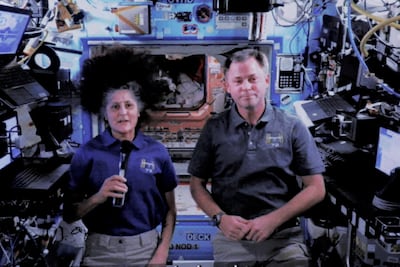She’s “the woman with the wild hair” – as US President Donald Trump referred last week to Sunita Williams (also known as Suni), the Nasa astronaut who, along with her colleague Butch Wilmore, has not been on Earth since June 5 of last year.
They were supposed to be up in orbit aboard the International Space Station (ISS) for eight days, having reached the station on the first crewed flight for Boeing's Starliner spacecraft. The trip went on quite a bit longer due to technical malfunctions and helium leaks in Starliner's propulsion system.
Capt Williams and Capt Wilmore, who spent their most recent birthdays in orbit – her 59th, his 62nd – finally on Tuesday began their 17-hour voyage home, on SpaceX’s Dragon spacecraft. After many months, they are back on Earth.
How many people can say that? Well, in 2023 the UAE's Sultan Al Neyadi went up for six months – the longest Arab space mission – and returned on schedule. And certainly, other accomplished astronauts have spent significant stretches of time in orbit.
Astronauts have continuously lived and worked aboard the ISS for more than two decades. They test technology, collect data for scientific research and develop the skills they need to propel humanity’s exploration farther afield.
Most of us Earth-bound folk, however, will never fully comprehend what it must feel like to do a spacewalk in a capacious astro-suit with a helmet and radio static in weightlessness.
The novelty factor of air travel for us ordinary people may provide, at best, catching two sunrises or two sunsets in a day of flight across time zones. And those are gorgeous, sure. If you’re awake and have a window seat to look at the sky, your mind might push off to a reflective place.
But none of this professional, gravity-defying stuff. Cue the Bob Dylan song about there being no direction home: How does it feel?...
Far from boring, apparently. Col Cady Coleman, a retired Nasa astronaut and veteran of two space shuttle missions, spent 159 days in space. “I would’ve spent another 159 days if I could”, she told the BBC. She added: “It might depend on the person, but I have not yet met an astronaut who was bored up there...”
Many will be eagerly awaiting these latest returnees to write a book, or at least be on a podcast, with the video – who would want to miss their gestures, the body language, perhaps Capt Williams conveying to Mr Trump that her hair wouldn't abide a ponytail because the missing gravitational force would render a hair claw useless?
Given the constraints of space life, Capt Williams could take Donald Trump's remarks with a pinch of salt. What he says naturally tends to make headlines, but he wasn’t inaccurate in his descriptions: “Good solid head of hair she’s got,”; “There’s no kidding, there's no games with her hair.”
Capt Wilmore, too, and the rest of their crew who joined later in September, Nasa astronaut Nick Hague and cosmonaut Aleksandr Gorbunov, might well have their own physical challenges. The stories of men and women who’ve spent any amount of time in space are always interesting – only more so for those who have hit remarkable endurance records on their journey.
In the mid-1990s, Russian cosmonaut Valeri Polyakov spent 437 days in space. A handful of women have similarly impressive records. Astronaut Peggy Whitson has a record of 675 cumulative days in space (in one go: 289 days), and Christina Koch has 328 days.

Being in space isn't easy on the human body – or the human mind. Do they sleep well? How much are they dreaming? Science says being in space accelerates ageing at a cellular level. The heart, blood vessels, bones and muscles deteriorate more than 10 times faster in space than by natural ageing.
The psychological toll is another big subject. Medical teams will be evaluating the crew on their return, as they have for mission members in the past, to get an idea of the demands and pitfalls of space expeditions on the human psyche.
When regular air travellers return home from a trip away, we might exhale and say mundane things about how there’s nothing like being back in your own bed. It may be no less true for weary and aged space travellers.
To finally enter the Earth’s atmosphere and be able to walk on ground must be a wonderful, familiar feeling. Astronaut or not, though, how is a human being trained to keep overwhelming emotions of having made it back in one piece in check?
These astronauts, as so many before and after them who will embark on missions, will probably spend weeks and months re-acclimatising to families, domesticity, their living rooms, their shampoo and hair care routines even, and generally feeling grounded and at home. The Williams and Wilmore families, too, and others, have probably traversed a universe of their own million anxieties in the past months.
How often is it the case, though, that after the rush and excitement of being back on Earth subsides, astronauts think back on their long months in space and how they spent their time? Do they, just a tiny bit, begin to yearn for the absence of gravity?












